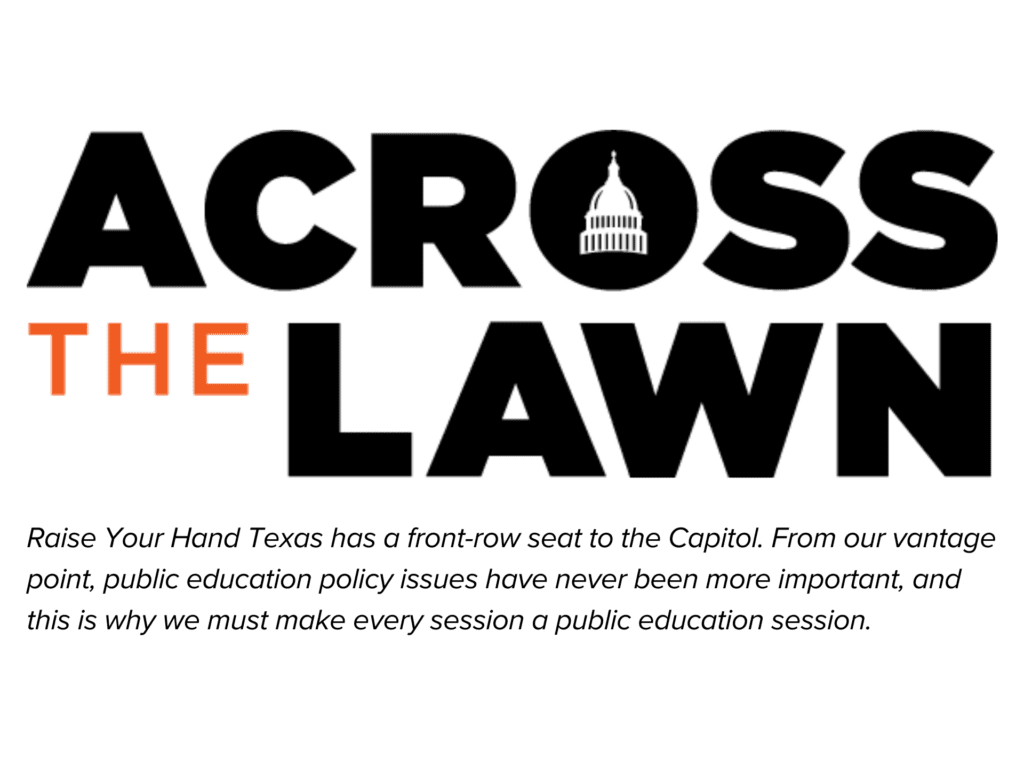
categories
Across the Lawn – January 24, 2025

January 24, 2025

One Thing to Do: Learn Who Represents You
Did you know we have a team of Regional Advocacy Directors across the state partnering with community members to advocate for public education? Explore our interactive map of Texas to find your Regional Advocacy Director and learn who represents you.
Six Things to Know:
1. House Releases State Budget Proposal for Next Biennium, $4.85 Billion for Public Education, $1 Billion for Vouchers
The initial state budget proposal, HB 1, was filed by the House for the 2026-27 biennium on Tuesday, January 21. There will be much debate in the coming months over the final amounts and details, but these recommendations will be the starting point for how Texas funds our public schools for the next two years.
The House recommendation for its budget proposal provides $4.85 billion in new funding for public schools–last session’s final state budget included $4 billion, but was left unspent due to school funding and voucher legislation stalling. The budget proposal also provides $1 billion contingent on establishing an Educational Savings Account program in the second year of the biennium, 2027. The bill also contains $400 million for school safety improvements and $450 million for the Teacher Retirement System to minimize premium increases.
In addition, the House recommends an additional $3.5 billion above current law for other forms of property tax relief contingent on the passage of legislation.
2. Senate Releases State Budget Proposal for Next Biennium, $5.3 Billion for Public Education, $1 Billion for Vouchers
The initial state budget proposal for the Senate, SB 1, was also filed on Tuesday, January 21. The recommendations include $5.3 billion in additional funding for public education. This includes a $4.9 billion increase for teacher pay and changes to the Teacher Incentive Allotment. The Senate also includes $400 million for school safety and $1 billion for a school choice program in the second year of the biennium, 2027.
Teacher pay, according to Lt. Governor Patrick’s press release, would increase by $4,000 for all teachers, plus an additional $6,000 for rural teachers, resulting in a $10,000 pay raise for rural teachers.
The Senate also provides $3 billion in additional tax relief by increasing the homestead exemption from $100,000 to $140,000 for regular homeowners and $150,000 for seniors. The bill also sets aside $500 million to provide property tax reductions to businesses.
Please note that included in the House and Senate budget estimates is a total of $51 billion in appropriations for the 2026–27 biennium for tax relief. This total amount maintains the property tax relief that has been granted in every legislative session since 2019, as well as any new property tax relief that may pass this legislative session.
3. Committee on Senate Education K-16 to Hear SB 2, Education Savings Account Bill
The Committee on Senate Education K-16 will hear SB 2 on Tuesday, January 28th at 9:00 a.m.
SB 2 by Sen. Creighton creates a statewide Education Savings Account program. This is a standalone bill and does not contain any public school funding provisions.
This bill allows the following:
- The bill, as filed, allows every Texas student to apply for an Education Savings Account (ESA), whether in public school, private school, or homeschool.
- If the applications do not exceed the program’s capacity (currently estimated to be $1 billion in 2027) then all students are accepted.
- If applications exceed the capacity, then 80% of the positions will be filled by lottery by those students who previously attended public school and are either from low-income households or have a disability.
- Each participating student will receive at least $2,000 or if a family elects to enroll their student in a private school, the student will receive $10,000 ($11,500 if the student has a disability).
Note: Low income is defined in the bill as 500% of the federal poverty guideline or a family income of $160,750 for a family of four.
4. TEA Releases Annual Report
The Texas Education Agency released its 2024 Annual Report. The report provides a comprehensive overview of our public schools, including school funding, STAAR, special education, and school safety.
5. Lt. Governor Patrick Names Senate Committee on Education K-16
The Lt. Governor announced the Senate Committee on Education K-16 last week. The new committee structure eliminated the Subcommittee on Higher Education and reduced the number of senators sitting on the committee from 13 to 11 members. The committee includes:
- Sen. Brandon Creighton, Chair
- Sen. Donna Campbell, Vice Chair
- Sen. Paul Bettencourt
- Sen. Brent Hagenbuch
- Sen. Adam Hinojosa
- Sen. Phil King
- Sen. José Menéndez
- Sen. Mayes Middleton
- Sen. Tan Parker
- Sen. Angela Paxton
- Sen. Royce West
6. House Finalizes Rules, No Democratic Chairs, Two New Committees
The House debated its rules of procedure on Thursday, January 23. The major rule changes include:
- Creating new Permanent Subcommittees (PSC), including the PSC on Academic and Career-Oriented Education within the Public Education Committee and the PSC on Property Tax Appraisals within the Ways and Means Committees Your Hand Texas, and JoLisa Hoover, Teacher Specialist at Raise Your Hand Texas.
- Restricting the appointment of a chair of a standing committee to those members of the political party that constitutes a majority of the house membership and to provide that a majority party member may not be appointed as a vice chair of a standing committee
- Abolishing six standing committees and transferring the authority over to other standing committees
- Creating two new standing committees: Delivery of Government Efficiency and Intergovernmental Affairs



